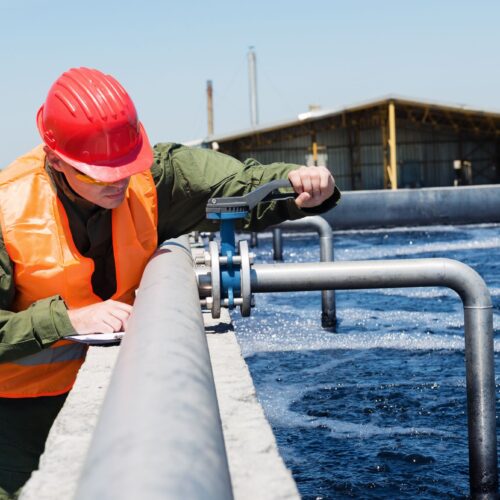
16
Aug
Transforming Wastewater into Safe, Usable Water
Comments
Manufacturing operations produce contaminated wastewater loaded with solids, chemicals, and organic matter that makes direct discharge or reuse impossible.
Thankfully, wastewater is treatable using physical separation, biological digestion, and chemical reactions to remove contaminants at each stage. Progressive cleaning turns unusable wastewater into water clean enough for your processes or environmental discharge without penalties.
Stage 1 — Wastewater collection and preliminary screening
Contaminated water from production lines flows into collection tanks where large debris gets filtered out before treatment begins. Screens catch plastics, rags, and solid waste that would otherwise clog pumps or damage equipment further down the line.
Sand, grit, and heavy particles settle in specially designed chambers that slow water flow and encourage sedimentation. Removing these abrasive materials early protects your treatment infrastructure and prevents costly equipment repairs throughout the process.
Stage 2 — Primary treatment
Large clarification tanks give wastewater time to separate into layers as heavier particles sink and lighter materials float. Half of the suspended solids and roughly one-third of organic matter settle out during this quiet period without any chemical additives.
Mechanical scrapers collect settled sludge from tank floors. Clear water overflows to the subsequent treatment stage. Simple gravity does most of the work, making primary treatment both energy-efficient and cost-effective for your operation.
Stage 3 — Biological treatment
Specially-bred bacteria consume dissolved organics in the same way they break down waste in natural water bodies, such as rivers and lakes.
Activated sludge tanks provide the perfect environment for these microbes with oxygen, nutrients, and plenty of food in concentrated wastewater.
Fixed-film systems grow bacterial colonies on plastic media or stone surfaces where they trap and digest pollutants from passing water. Constant airflow keeps these biological workers active as they convert harmful organics into harmless carbon dioxide and water.
Stage 4 — Chemical treatment
Acids and alkalis in wastewater can destroy equipment and kill the beneficial bacteria used in biological treatment stages.
Adding chemicals to balance pH levels protects your investment and keeps treatment processes running smoothly without unexpected shutdowns.
Coagulants grab tiny suspended particles and stick them together into clumps heavy enough to sink or float away. Gentle mixing encourages these clusters to grow larger, and precipitation chemicals convert dissolved metals into solid waste that separates easily.
Stage 5 — Ultrafiltration
Membrane filtration blocks particles, bacteria, and viruses that escaped previous treatment stages. UF membranes have pores small enough to stop pathogens whilst allowing dissolved salts and organics to pass downstream.
Ultrafiltration produces consistent water quality regardless of upstream variations in treatment performance. Membranes require regular cleaning to maintain flux rates and prevent fouling that reduces filtration capacity over time.
Stage 6 — Reverse osmosis
High-pressure membranes extract dissolved salts, organic compounds, and remaining contaminants from pre-filtered water. RO systems force water molecules through semi-permeable membranes that reject larger dissolved substances.
Reverse osmosis produces high-purity water suitable for sensitive applications at your facility or environmental discharge. Concentrated streams containing rejected contaminants require proper disposal or further treatment to recover additional water.
Stage 7 — Mixed-bed deionisation
Ion exchange resins capture the remaining dissolved minerals to achieve ultra-pure water quality. Cation resins grab positively charged ions, and anion resins extract negatively charged species in a single treatment step.
Deionisation polishes RO permeate to meet strict specifications for electronics manufacturing, pharmaceutical production, or boiler feedwater. Regeneration chemicals restore resin capacity when exchange sites become saturated with captured ions.
Stage 8 — Monitoring and quality control
Online analysers measure key parameters like pH, conductivity, turbidity, and dissolved organics across the treatment process. Automated systems alert operators to performance deviations that require immediate attention or corrective action.
Laboratory testing verifies compliance with discharge permits and reuse specifications. Regular sampling ensures treatment effectiveness and identifies potential problems before they compromise water quality or regulatory compliance.
Stage 9 — Production-ready water
Clean water emerges from the final treatment stage, ready for whatever purpose you need it to serve. Storage vessels hold treated water until production demands it, and pumps return the clean supply to manufacturing lines or out to approved discharge points.
How clean the water needs to be is dependent on where it goes next and what regulations govern your industry.
For instance, cooling towers might accept water that drinking water standards would reject, but water for rinsing in kitchen facilities will need to meet potable standards.
Find out more
Membracon builds the membrane systems that handle stages five through seven, where contaminated water becomes genuinely clean. Ultrafiltration, reverse osmosis, and deionisation technologies work together to remove the toughest contaminants that earlier stages cannot touch.
Contact us for a chat about how we can help you.
